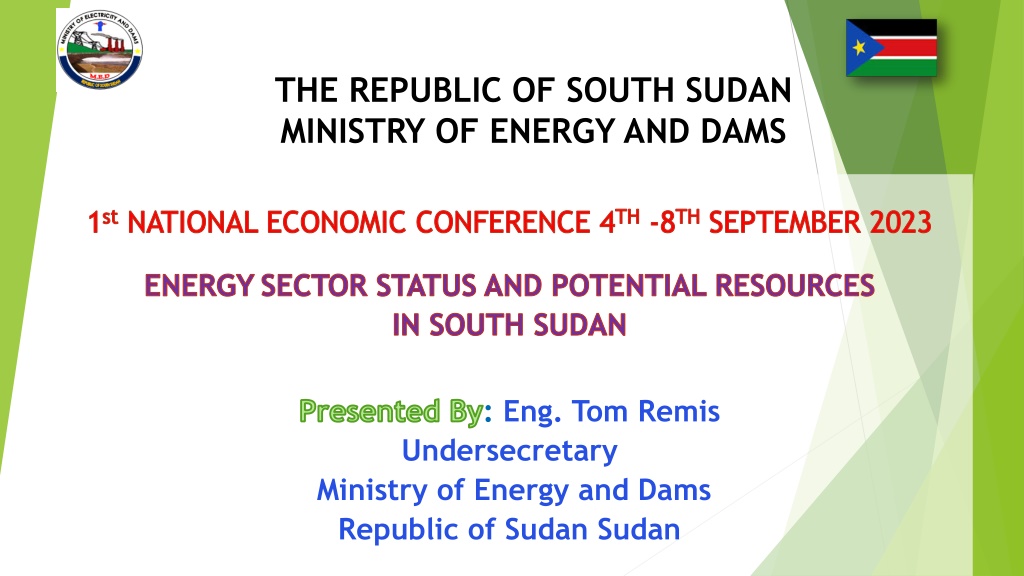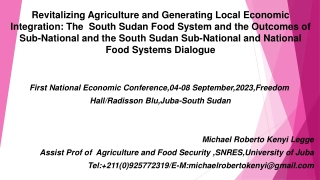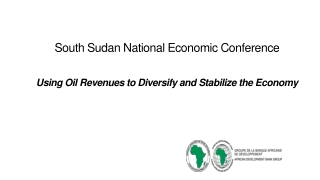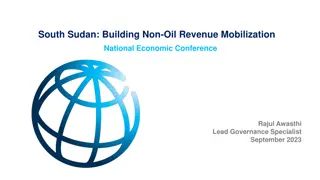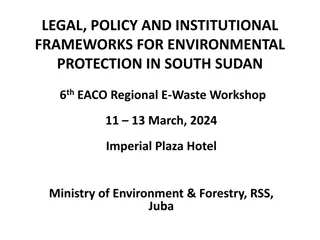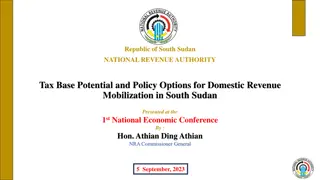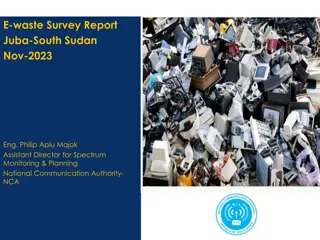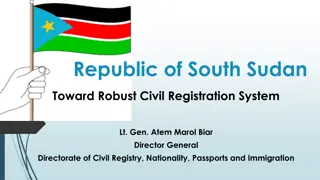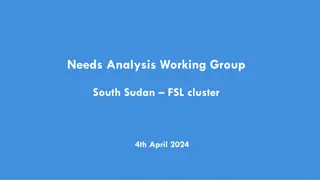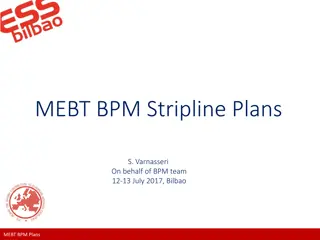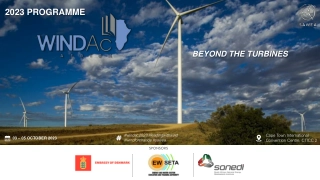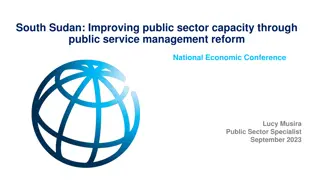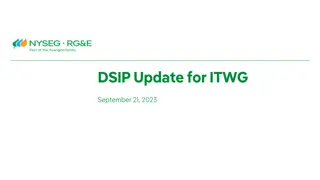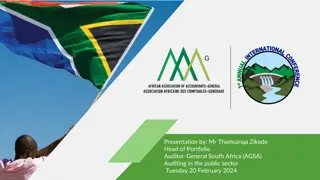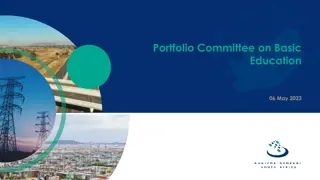Energy Sector Status and Potential Resources in South Sudan
The Republic of South Sudan has the lowest energy access rate in Sub Sahara Africa, with per capita consumption of 3kWh. The demand for electricity is expected to grow annually, pushing for more sustainable and cost-effective energy solutions. The country's current installed capacities include diesel and solar power plants, with plans for future projects and transmission lines. The energy policies aim to provide affordable and reliable electricity services to support socio-economic development.
Download Presentation
Please find below an Image/Link to download the presentation.
The content on the website is provided AS IS for your information and personal use only. It may not be sold, licensed, or shared on other websites without obtaining consent from the author. Download presentation by click this link. If you encounter any issues during the download, it is possible that the publisher has removed the file from their server.
Presentation Transcript
THE REPUBLIC OF SOUTH SUDAN MINISTRY OF ENERGY AND DAMS 1stNATIONAL ECONOMIC CONFERENCE 4TH-8THSEPTEMBER 2023 ENERGY SECTOR STATUS AND POTENTIAL RESOURCES IN SOUTH SUDAN Presented By: Eng. Tom Remis Undersecretary Ministry of Energy and Dams Republic of Sudan Sudan
TABLE OF CONTENT 1. Energy Overview 2. Energy Policies and Strategies 3. Potential Energy Resources 4. Future Plan Projects i. Short and Medium Terms ii. Long Term 5. Transmission Lines Projects i. Inter-States Power Transmission Lines ii. Power Interconnection Transmission Lines 6. Challenges 7. Recommendations 8. Conclusions
ENERGY OVERVIEW Although energy access rates are generally low in Sub Sahara Africa, the Republic of South Sudan (RSS) has the lowest rate (7%) and Per capita consumption of 3kwh. The total installed capacity is 87MW. There is no national grid (High Voltage Transmission Lines), only there are isolated distribution networks (Medium & Low Voltages) in some of the states. The Growth of electricity sector in South Sudan is suppressed by supply not the demand.
ENERGY OVERVIEW (Cont.) The demand for electricity is expected to increase by 7% to 8% annually based on the economic growth rate. The power plants in South Sudan currently are burning diesel/heavy fuel oil(HFO); a very expensive and environmentally hazardous fuel for power generation. The average generation cost is 0.373US$/kWh and the average tariff is 0.395US$/kWh.
ENERGY OVERVIEW (Cont.) THE CURRENT INSTALLED CAPACITIES No Name Power Plant Location Capacity (MW) Source of Energy Status 1. EZRA Diesel Power Plant Juba 33 Diesel Operational 2. EZRA Solar PV Juba 20 Solar Expected to be commissioned in October 2023 Completed, but not commissioned due to non payment Expected to be commissioned in December 2023 Completed waiting commissioning Rehabilitation still on going 3. Nesitu Solar PV Juba 20 Solar+Batteries 4. Wau Power Pant Wau 8 Diesel/HFO 5. Rumbek Power Plant Rumbek 2 Diesel 6. Yambio Power Plant Yambio 2 Diesel 7. Bor Power Plant Bor 2 Diesel Operational
ENERGY OVERVIEW (Cont.) Expected Electricity Demand in South Sudan (MW) 1600 1400 1200 1000 800 600 400 200 0 2020 2025 2030 2035 2040
ENERGY POLICIES AND STRATEGIES The South Sudan Energy National Policies and Strategies are guided by the Vision and Mission of the Ministry of Energy and Dams that is to provide Cost-effective, accessible, reliable, affordable and sustainable electricity services to meet the Socio-economic and development needs of the country; The developed Energy Policies and Strategies are: Encouragement of the development of Electricity through renewable power resources; (Transition to Green Energy) Construction of Hydropower plants and Dams to supply cheap, reliable and sustainable electricity to meet domestic, commercial and industrial demands in South Sudan; The Power sector in South Sudan shall consist of mix of Public and Private sector services providers that engage in electricity generation, transmission and distribution enterprises.
ENERGY POLICIES AND STRATEGIES (Cont.) Construction of electricity transmission national grid to supply electricity to targeted parts of South Sudan; Putting Legal Framework in place to encourage investors to invest in the field of electricity generation and supply through Private Public Partnership (PPP) and Independent Power Producer (IPP) investment; Mobilize loans from foreign sources for the development of electricity sector in South Sudan; Development of the energy institution and capacity building to enhance energy efficiency delivery;
ENERGY POTENTIAL RESOURCES 1. Hydropower Potential S/N PROJECT NAME CAPACITY (MW) STATUS 1. Grand Fulla 1080 Feasibility Studies completed 2009, need payment and update. 2. Shukoli 240 3. Lakki 420 4. Bedden 540 - 570 5. Sue Mini Hydro 10.4 - 12 Need funding for Studies and development. 6. Katire Mini Hydro 1.92 - 2
HYDRO PLOTENTIAL LOCATIONS Bedden Lakki Shukoli Grand Fula
ENERGY POTENTIAL RESOURCES ii. SOLAR The RSS experiences approximately 12 hours/day of sunshine all round the year and radiation is 4.0 to 6.0 kwh/m /day. iii. WIND Wind power density in South Sudan is at the high lands bordering Kenya and Uganda ranging from 285 380 W/m ; wind velocity is 12.5m/s.
ENERGY POTENTIAL RESOURCES iv. BIOMASS iv. BIOMASS Is estimated at 71.1 million hectares, and is the source of energy to majority of the population. v. GEOTHERMAL The country geographical conditions are favorable to geothermal resources; However, they have not been explored.
ENERGY POTENTIAL RESOURCES vi. Fossil Fuel Thermal Power Potential S/N PROJECT NAME Location CAPACITY (MW) STATUS 1. Tharjath Power Plant Unity State 300-500 Need Funding and Development 2. Polouge Power Plant Upper Nile State 500-750
IMMEDIATE PRIORITY PROJECTS SHORT MEDIUM TERMS
1. OFF-GRID PV SOLAR POWER PROJECTS S/N LOCATION CAPACITY (MW) STATUS 1. 2. 3. 4. 5. 6. 7. 8. 9. 9. 10. Malakal Torit Awiel Wau Rumbek Yambio Bor Pibor Rweng Bentiu Kuajok 50 20 20 20 10 10 20 10 10 10 20 REQUIRE FUNDING FOR FEASIBILITY STUDIES AND DEVELOPMENT
2. REGIONAL INTERCONNECTION TRANSMISSION LINES S/N Project Name Voltage (kV) Distance (Km) 382 Project Status 1. Uganda (Olwiyo)-South Sudan (Nimule-Juba). 400 i. Feasibility Study is now going on funded by the Afdb. ii. Need funding for construction Funding is needed to implement the Contract 2. Ethiopia (Gambella)- South Sudan ( Malakal) (Phase 1) 230 357 3. Renk - Malakal 220 353
3. INTER-STATE TRANSMISSION LINES PROJECT (NATIONAL GRID) S/N Overhead Transmission Line Level (kV) Voltage Est. Distance (km) Configuration 1. Juba Bor Ayot Malakal 2. Juba -Ramciel- Rumbek Wau- Tharjath- Bentiu 3. Wau-Kuajok- Awil- Raja- Abyei 4. Juba -Mundri-Maridi- Yambio-Tombura 5. Juba -Torit-Kapoeta 6. Juba-Yei- Kaya-Kojikeji 400 517 Single Circuit 400 934 Single Circuit 220 233 Single Circuit 220 690 Single Circuit 220 132 359 280 Single Circuit Single Circuit
FUTURE PRIORITY PROJECTS LONG TERM
THE PRIORITY HYDRO POWER PROJECT 1. GRAND FULA HYDROPOWER White Nile River, 34km down stream of Nimule, and 137km upstream from Juba
Basic Information of Grand Fula Hydropower Project Details Project Name S/N 1 Comments Grand Fula Hydropower Project 2 Location White Nile River, 34Km down Stream of Nimule, and 137 Km upstream from Juba. 1080 MW 3 Capacity 4 Cost of Investment US$1.5 Billion 5 Cost of Average Energy 6$cent per Kwh 6 Project Mode Finance, Build, Operate and Transfer (BOT) 7 Implementation Period 75 Months
THE OBJECTIVES OF GRAND FULA HYDROPOWER PROJECT (i) To supply Cheap, Reliable, Affordable and Sustainable electricity power to meet Residential, Commercial, Agricultural and Industrial demand for socio-economic development to the people of South Sudan; (ii) To supply extra electricity power to East African Power Pool(EAPP) for widening the Country electricity power trade in the region.
THE PROCEEDES OF GRAND FULA HYDRO POWER PROJECT AND THE WAY FORWARDS (i) The Feasibility Studies completed in 2009, but still the Government of South Sudan needs to meet the payment of US$12 million to own and update the documents; (ii) The Government of the Republic of South Sudan avails the opportunity and invites the potential investor/s to develop the Grand Fula Hydropower as it s Top Energy Priority Project to electrify the countrywide.
2. INTERCONNECTION TRANSMISSION LINES S/N Overhead Transmission Line 1. Ethiopia (Dedesa- Tepi)-South Sudan (Bor- Juba) (Phase 2) 2. Kenya (Lokichogio)- South Sudan (Kapeota-Torit-Juba) Voltage Level (kV) 400 Est. Distance (km) 700 Project Status Need Funding for Feasibility Study and Construction 220 480
CHALLENGES 1. The energy projects are capital intensive need access to capital; 2. Regulations and conditions imposed by lenders before approving a loan.(Government to provide 15 to 20% down payment; 3. In-adequate infrastructures.
RECOMMENDATIONS 1. The Government of South Sudan has to prioritize energy as a critical input to the country s recovery program, stability and development. 2. Grand Fula Hydropower Project is strongly recommended as the Top Energy Priority Project for the socio-economic development of the people of South Sudan. 3. The Government has to acknowledge the need to develop the Intuitional capacity and Capacity building of the energy sector.
CONCLUSIONS South Sudan has abundant energy resources waiting to be harnessed for development to uplift the standard living of its people. 1. There is massive investment opportunities in the energy sector, which require resources for infrastructure development from the Government, Investors and Donors. 2. The expectations of the economy and the people of South Sudan are great and will require also the prioritization of the energy sector as the driving wheel of the development. 3. 26
THANKS FOR YOUR ATTENTION
